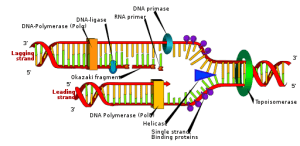
Table of Contents
ToggleDNA Replication: Unwinding the Secrets of Our Genetic Blueprint
Replication is the process in which genetic information is passed on to the next generation. In eukaryotes, this process takes place in the nucleus of the cell. Because prokaryotes do not have a nucleus, replication occurs in the cytoplasm. This multi-step process employs the help of various enzymes to ensure that DNA is accurately copied, providing the building blocks of life. Let’s dive into the details of DNA replication and understand how our genetic blueprint is passed on.
🧬 DNA Replication: Step by Step
DNA is twisted by nature, so the first step is to unwind and break the hydrogen bonds. A protein called helicase unwinds the DNA strands and breaks the hydrogen bonds between each of the bases. But as you know, unwound things tend to twist back up. This is where topoisomerase and single-strand binding proteins come into play, relaxing the coil in front of the replication fork and preventing it from recoiling. Now, it’s time for the actual replication.
The enzyme DNA polymerase III has the main job of adding corresponding nucleotides to the template strand. But here’s the catch: DNA polymerase III can’t start on its own. It needs help from RNA primase, which adds a short RNA primer—a few RNA nucleotides—to give DNA polymerase III a starting point.
Once the initial nucleotides are added, DNA polymerase I steps in to proofread and correct mistakes. It also replaces the RNA primers with DNA nucleotides. Finally, ligase acts as the glue, linking the newly replicated segments to form a continuous DNA strand.
Here’s a quick rundown of the key players:
Helicase: Scissors—unwinds and cuts the DNA.
Topoisomerase and Single-Strand Binding Proteins: Relaxers—keep the DNA from recoiling.
DNA Polymerase III: Copier—adds nucleotides to form the new DNA strand.
RNA Primase: Initiator—lays down RNA primer to help DNA Polymerase III start.
DNA Polymerase I: Editor—fixes mistakes and replaces RNA primers.
Ligase: Glue—links the fragments together.

The Leading and Lagging Strand
DNA replication is a semi-conservative process, which means it uses one strand of the original DNA as a template to create another. The process occurs in the 5’ → 3’ direction, referred to as the leading strand. But DNA is double-stranded, and the other side—the lagging strand—runs in the opposite 3’ → 5’ direction. DNA polymerase III can only work in the 5’ → 3’ direction, making replication of the lagging strand tricky.
To overcome this, DNA polymerase III works in small segments called Okazaki fragments on the lagging strand. These fragments are then glued together by ligase to form a continuous strand. While the leading strand is replicated continuously, the lagging strand requires a more fragmented, stop-and-go process to get the job done.
The Challenges of Replication
Unfortunately, DNA replication isn’t a perfect process. The DNA polymerase III requires space to bind to the template, meaning that each time DNA replicates, a few bases are not copied. To compensate, the body uses telomeres—repetitive, non-coding sequences at the ends of chromosomes. Over time, as telomeres shorten with each replication, important DNA sequences can still be preserved for as long as possible. However, when telomeres are depleted, cells eventually stop functioning and enter a state called cellular senescence.
Conclusion: Unwind, Copy, Proofread, and Glue
DNA replication is a fascinating, highly coordinated process involving several specialized proteins. Helicase unwinds the DNA, topoisomerase and single-strand binding proteins prevent recoiling, and DNA polymerase III works with RNA primase to replicate the strands. DNA polymerase I then edits, and ligase glues everything together. The lagging strand, with its Okazaki fragments, adds a bit of complexity to the process but ultimately ensures that both DNA strands are faithfully copied.
Try explaining this to a friend or to yourself—teaching others is one of the best ways to reinforce your own understanding of complicated processes like DNA replication!
Recent Posts
- 1.4 Understanding and interpreting a narrator’s perspective
- 1.3 Understanding how a story’s structure affects interpretations
- 1.2 Identifying and interpreting setting
- 1.1 Interpreting the role of character in fiction
- Unit 1 Overview: Introduction to Short Fiction
- Laws of Indices – Number & Algebra – IB Mathematics AA HL
- Standard Form – Number & Algebra – IB Mathematics AA HL
- 9.2 Crafting an argument through stylistic choices like word choice and description
- 9.1 Strategically conceding, rebutting, or refuting information
- Unit 9 Overview: Developing a Complex Argument
- 8.4 Considering how style affects an argument
- 8.3 Considering how all choices made in an argument affect the audience
- 8.2 Considering how sentence development and word choice affect how the writer is perceived by an audience
- 8.1 Choosing comparisons based on an audience
- Unit 8 Overview: Stylistic Choices
Choose Topic
- ACT (17)
- AP (20)
- AP Art and Design (5)
- AP Physics 1 (1)
- AQA (5)
- Artificial intelligence (AI) (2)
- Banking and Finance (6)
- Biology (13)
- Business Ideas (68)
- Calculator (72)
- ChatGPT (1)
- Chemistry (3)
- Colleges Rankings (48)
- Computer Science (4)
- Conversion Tools (136)
- Cosmetic Procedures (50)
- Cryptocurrency (49)
- Digital SAT (3)
- Edexcel (4)
- English (1)
- Environmental Science (2)
- Exam Updates (1)
- Finance (17)
- Fitness & Wellness (164)
- Free Learning Resources (209)
- GCSE (1)
- General Guides (40)
- Health (107)
- History and Social Sciences (152)
- IB (1)
- IGCSE (2)
- Image Converters (3)
- IMF (10)
- Math (39)
- Mental Health (58)
- News (8)
- OCR (3)
- Past Papers (463)
- Physics (5)
- SAT (39)
- Schools (3)
- Sciences (1)
- Short Notes (5)
- Study Guides (28)
- Syllabus (19)
- Tools (1)
- Tutoring (1)

